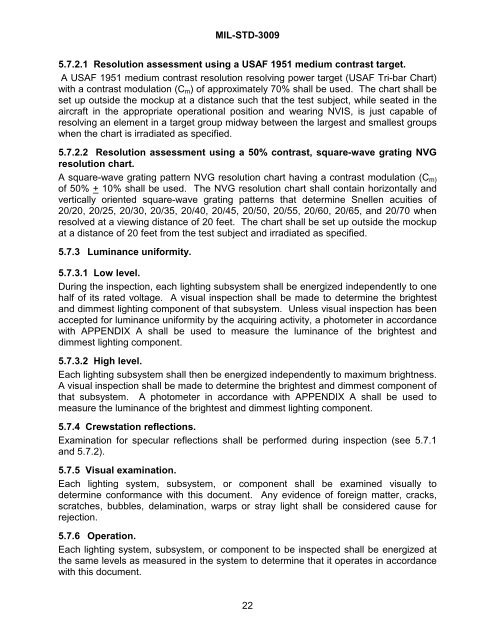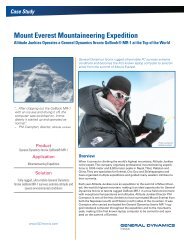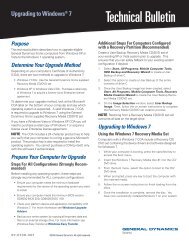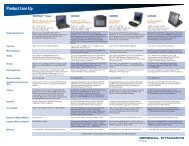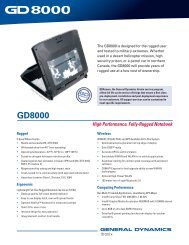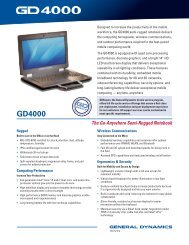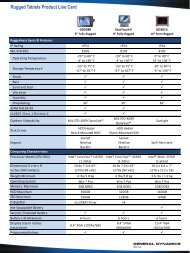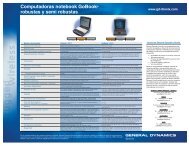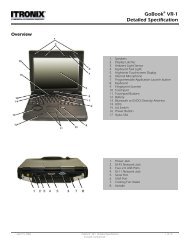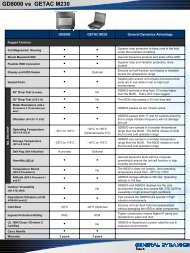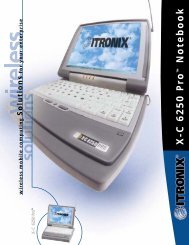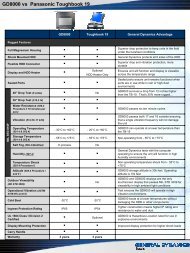lighting, aircraft, night vision imaging system - General Dynamics ...
lighting, aircraft, night vision imaging system - General Dynamics ...
lighting, aircraft, night vision imaging system - General Dynamics ...
Create successful ePaper yourself
Turn your PDF publications into a flip-book with our unique Google optimized e-Paper software.
MIL-STD-3009<br />
5.7.2.1 Resolution assessment using a USAF 1951 medium contrast target.<br />
A USAF 1951 medium contrast resolution resolving power target (USAF Tri-bar Chart)<br />
with a contrast modulation (Cm) of approximately 70% shall be used. The chart shall be<br />
set up outside the mockup at a distance such that the test subject, while seated in the<br />
<strong>aircraft</strong> in the appropriate operational position and wearing NVIS, is just capable of<br />
resolving an element in a target group midway between the largest and smallest groups<br />
when the chart is irradiated as specified.<br />
5.7.2.2 Resolution assessment using a 50% contrast, square-wave grating NVG<br />
resolution chart.<br />
A square-wave grating pattern NVG resolution chart having a contrast modulation (Cm)<br />
of 50% + 10% shall be used. The NVG resolution chart shall contain horizontally and<br />
vertically oriented square-wave grating patterns that determine Snellen acuities of<br />
20/20, 20/25, 20/30, 20/35, 20/40, 20/45, 20/50, 20/55, 20/60, 20/65, and 20/70 when<br />
resolved at a viewing distance of 20 feet. The chart shall be set up outside the mockup<br />
at a distance of 20 feet from the test subject and irradiated as specified.<br />
5.7.3 Luminance uniformity.<br />
5.7.3.1 Low level.<br />
During the inspection, each <strong>lighting</strong> sub<strong>system</strong> shall be energized independently to one<br />
half of its rated voltage. A visual inspection shall be made to determine the brightest<br />
and dimmest <strong>lighting</strong> component of that sub<strong>system</strong>. Unless visual inspection has been<br />
accepted for luminance uniformity by the acquiring activity, a photometer in accordance<br />
with APPENDIX A shall be used to measure the luminance of the brightest and<br />
dimmest <strong>lighting</strong> component.<br />
5.7.3.2 High level.<br />
Each <strong>lighting</strong> sub<strong>system</strong> shall then be energized independently to maximum brightness.<br />
A visual inspection shall be made to determine the brightest and dimmest component of<br />
that sub<strong>system</strong>. A photometer in accordance with APPENDIX A shall be used to<br />
measure the luminance of the brightest and dimmest <strong>lighting</strong> component.<br />
5.7.4 Crewstation reflections.<br />
Examination for specular reflections shall be performed during inspection (see 5.7.1<br />
and 5.7.2).<br />
5.7.5 Visual examination.<br />
Each <strong>lighting</strong> <strong>system</strong>, sub<strong>system</strong>, or component shall be examined visually to<br />
determine conformance with this document. Any evidence of foreign matter, cracks,<br />
scratches, bubbles, delamination, warps or stray light shall be considered cause for<br />
rejection.<br />
5.7.6 Operation.<br />
Each <strong>lighting</strong> <strong>system</strong>, sub<strong>system</strong>, or component to be inspected shall be energized at<br />
the same levels as measured in the <strong>system</strong> to determine that it operates in accordance<br />
with this document.<br />
22


